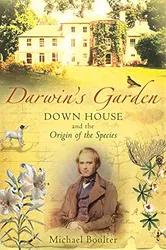A few years after his voyage around the world on the Beagle, Charles Darwin moved with his wife, Emma, to Down House in Kent. It was here that he wrote On the Origin of Species as well as several other books. Darwin’s Garden describes his time at Down and how the house, and particularly its extensive gardens, influenced Darwin’s work. As well as inspiration from the nature he saw around him, the gardens provided lots of scope for Darwin to experiment, and allowed him to produce evidence for his theory of natural selection.
Darwin moved to the village of Downe (the village has gained the ‘e’ since Darwin’s time, while the house has not) in order to retreat from the hustle of life in London, but he still maintained correspondence with the scientists of the day, and had friends and colleagues visit him at Down House, as well as making trips into London himself. As his ideas developed, this book covers some of the letters he sent and received, both agreeing and disagreeing with other scientists. These collaborators influenced his thinking, such as the geologist Charles Lyell who maintained that the Earth was much older than people supposed at the time.
Darwin figured out the basics of his theory many years before publishing. He wrote an essay about them, but never published it. He was worried that he needed much more evidence to back up his theory, and later on he became worried about the religious backlash that might come his way after publishing a theory that seemed to dismiss the idea of a creator god.
Charles Darwin comes across as a very thoughtful man, always thinking and experimenting with his ideas about evolution. Most of the book is written from the perspective of the time, and the ideas as they were being developed by Darwin. So there is talk of “gemmules” instead of genes, and no mention of DNA during the earlier part of the book. As with The Origin of Species itself, many of Darwin’s ideas were right, some were wrong, and others fall into the category of being expressed in ways that have been superseded by modern ideas, so it’s hard to tell if they were correct or not.
The latter part of the book aims to reflect on how Darwin’s ideas were developed by the scientists who came later, and the influence those ideas had on the world in general. I expected this part to put Darwin’s ideas into context, and clarify which ideas have been confirmed by more modern science, and what effect these ideas have had on our understanding of the natural world. This book doesn’t particularly aim to explain or clarify a modern understanding of evolution though, and I think this last section of the book is less clear than it could be as a result. Ideas are mentioned but it’s not made clear if they have been validated by modern scientific methods or not.
The author seems even a little sceptical about modern understandings of evolution and our ability to understand the natural world. At the end he says that nature “is too cunning for humans’ scientific progress to monitor, let alone catch.” Perhaps this is really a history book and not a science book. Or perhaps the author is arguing against a reductive view of life and thinks it should be viewed in its entirety or not at all. But science works by breaking large complex things down into small parts we can understand, which is exactly what Charles Darwin, as a scientist, was attempting to do. And since Darwin, humans have made enormous progress in understanding life! To me, Darwin had basically the right idea, but there were some gaps in his knowledge. What actually transmits the information from parent to child about how to make an organism? How long has the Earth existed for, when did life develop and has there been enough time for the life we see now to have evolved? How do complex organs like eyes evolve? This book describes Darwin wrestling with these questions as he develops his theory. In the time since Darwin, all of these questions have been answered. We can now look at (and even edit!) the DNA of organisms, we have lots of methods of dating rocks to figure out the age of the Earth. Science has filled in the gaps left by Darwin and his immediate successors, vindicated Darwin’s views, and given us a much more complete picture of how life develops. I don’t think this book does a good enough job of making this point, or of clarifying which of Darwin’s ideas have had the most influence and impact, and which turned out to be incomplete or incorrect.
Despite these reservations, I did enjoy reading this book. I liked the descriptions of Down House and the lifestyle that the Darwins enjoyed there, and the portrayal of the character of Charles Darwin himself. It was interesting to learn more about how Darwin developed his theories and the care and attention he took to validate their correctness before publishing.
By the way, if you haven’t visited Down House and you can make the trip, I would highly recommend it! I visited a few years ago, and having done so it made the places described in this book much more vivid for me.
